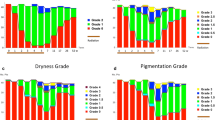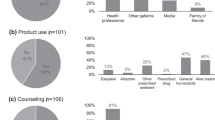Abstract
Purpose
To evaluate the effect of patient factors on radiation dermatitis for patients with breast cancer who underwent postoperative radiotherapy after breast-conserving surgery.
Materials and methods
The study population comprised 87 patients who underwent breast-conserving surgery followed by 50 Gy/25 fractions (median) of radiotherapy with or without boost radiation (10 Gy/5 fractions). We examined their treated and contralateral breast skin color by use of an objective analyzer, and expressed findings as L*, a*, b* ratios by dividing by pre-RT values. Next, we examined correlation between patient factors (age, height, body weight, and body mass index, BMI) and change of L* and a* values by use of correlation coefficients.
Results
Radiation therapy caused changes in a* and L* ratios (p < 0.0001) but not in b* ratio. The a* ratio (reddish) increased 1.4-fold and peaked after radiotherapy. The L* ratio (darkening) decreased by 10 % and reached a minimum value between completion of radiotherapy and 1 month after treatment. Although, age and height did not affect Δ value, body weight and BMI correlated significantly with Δa* value (p = 0.0012 and 0.0017) not with ΔL* value.
Conclusion
Body weight and BMI predict degree of radiation dermatitis, and more reddish dermatitis was observed for heavier patients than for their lighter counterparts.




Similar content being viewed by others
References
Engel J, Kerr J, Schlesinger-Raab A, Sauer H, Hölzel D. Quality of life following breast-conserving therapy or mastectomy: result of a 5-year prospective study. Breast J. 2004;10:223–31.
Cipollaro AC, Crossland PM. X-rays and radium in the treatment of diseases of the skin. Philadelphia: Lea and Febiger; 1967. p. 15–9.
Damian DL, Halliday GM, Barnetson RS. Prediction of minimal erythema dose with a reflectance melanin meter. Br J Dermatol. 1997;136:714–8.
Wei L, Xuemin W, Wei L, Li L, Ping Z, Yanyu W, et al. Skin color measurement in Chinese female population: analysis of 407 cases from 4 major cities of China. Int J Dermatol. 2007;46:835–9.
Yun IS, Lee WJ, Rah DK, Kim YO, Park BY. Skin color analysis using a spectrophotometer in Asians. Skin Res Technol. 2010;16:311–5.
de Rigal J, Des Mazis I, Diridollou S, Querleux B, Yang G, Leroy F, Barbosa VH. The effect of age on skin color and color heterogeneity in four ethnic groups. Skin Res Technol. 2010;16:168–78.
Tanaka E, Yamazaki H, Yoshida K, Takenaka T, Masuda N, Kotsuma T, et al. Objective and longitudinal assessment of dermatitis following post-operative accelerated partial breast irradiation (APBI) using high dose rate interstitial brachytherapy (HDR-ISBT) in patients with breast cancer treated with breast conserving therapy: reduction of moisture deterioration by APBI. Int J Radiat Oncol Biol Phys. 2011;81:1098–104.
Yamazaki H, Yoshida K, Kotsuma T, Kuriyama K, Masuda N, Nishimura T, et al. Longitudinal practical measurement of skin color and moisture during and after breast conserving therapy: influence of neoadjuvant systemic therapy. Jpn J Radiol. 2009;27:309–15.
Yoshida K, Yamazaki H, Takenaka T, Tanaka E, Kotsuma T, Fujita Y, et al. Objective assessment of dermatitis following post-operative radiotherapy in patients with breast cancer treated with breast-conserving treatment. Strahlenther Onkol. 2010;186:621–9.
Momm F, Bartelt S, Haigis K, Grosse-Sender A, Witucki G. Spectrophotometric skin measurements correlate with EORTC/RTOG-common toxicity criteria. Strahlenther Onkol. 2005;181:392–5.
Hymes SR, Strom EA, Fife C. Radiation dermatitis: clinical presentation, pathophysiology, and treatment. J Am Acad Dermatol. 2006;54:28–46.
Mendelsohn FA, Divino CM, Reis ED, Kerstein MD. Wound care after radiation therapy. Adv Skin Wound Care. 2002;15:216–24.
Archambeau JO, Pezner R, Wasserman T. Pathophysiology of irradiated skin and breast. Int J Radiat Oncol Biol Phys. 1995;31:1171–85.
Chen MF, Chen WC, Lai CH, Hung CH, Liu KC, Cheng YH. Predictive factors of radiation-induced skin toxicity in breast cancer patients. BMC Cancer. 2010;23:508.
Author information
Authors and Affiliations
Corresponding author
About this article
Cite this article
Yamazaki, H., Yoshida, K., Kobayashi, K. et al. Assessment of radiation dermatitis using objective analysis for patients with breast cancer treated with breast-conserving therapy: influence of body weight. Jpn J Radiol 30, 486–491 (2012). https://doi.org/10.1007/s11604-012-0073-8
Received:
Accepted:
Published:
Issue Date:
DOI: https://doi.org/10.1007/s11604-012-0073-8




